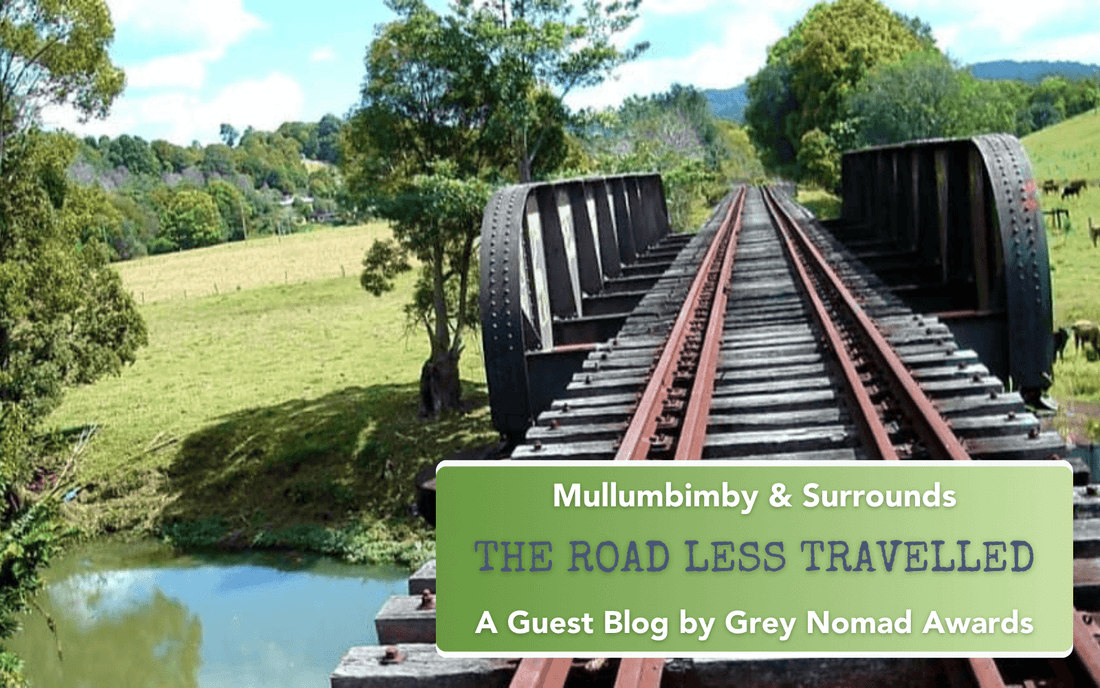
The Road Less Travelled - Guest Blog by Grey Nomad Awards
Share
A guest blog featuring our local area, thank you Grey Nomad Awards.
Follow Grey Nomad Awards on Facebook to discover more interesting stores of their travels...................
Taking the roads less travelled means popping into the little towns and old roadside stops that our mega highways now bypass.
And the old highway that runs south from Murwillumbah is a trip back in time, with numerous tiny towns and one big big bike.
Firstly, the bike. It's a YZR500 replica, three times the size of the real motorbike ridden by racing legend Wayne Rainey in 1993, and sits outside the Moo Moo Roadhouse in the fantastically named town of Mooball. It took the roadhouse owners countless hours back in 2014 to restore and re-create the exacting replica, right down to the original sponsorship stickers.
And that act of dedication caused quite a stir because the original backers were a cigarette brand. By 2014 cigarette advertising was illegal and so the custom-made cigarette brand stickers on the replica had to be removed - or the roadhouse owner could have been slapped with a $20K fine!
Regulatory absurdity aside, this is a very quirky place to take a pitstop. You know you've reached Mooball when you see the cow hide-painted light poles and petrol bowsers.
This town's a fitting home for the bike given the smooth open runs, bends and twists of the old highway which attracts lots of motorcyclists - even mid-week!
In addition to lots of moo theming, the roadhouse also boasts motoring memorabilia and vintage transport trinkets, a cafe and outdoor seating surrounded by lush hills.
Mooball is one of four tiny towns we trundled through:
Burringbar - home to Heath's Old Wares, which is packed with everything from wooden pulleys to door handles to glass bouys to... uh, almost everything.
Crabbes Creek - one road in and out with a cool general store come bottlo.
Billinudgel - the biggest of the little towns thanks to its railway history and close proximity to the coast. In fact, Ocean Shores has almost expanded to envelope Billinudgel these days. And if you're a reader of The Monthly, then you might recognise the name thanks to politico journalist Mungo MacCallum's 'The View from Billinudgel' regular opinion feature. It's bold, just like MacCallum. *Yes, apparently he's a local.
At Billinudgel, the old highway heads off up a hill along the narrow minor route called ^Tunnel Road towards Mullumbimby. A curious name as we certainly didn't see any tunnels!
Notes from Stewart's Menswear: *Yes, Mungo is a much loved local who also writes for our local newspaper the Byron Shire Echo. Sadly Mungo passed away the day after this story was posted.
^The railway track to Murwillumbah ran alongside the Tunnel Road. There are a number of tunnels that the track went through, hence the name Tunnel Road.

Mullumbimby, it's as far up river as the timber cutters could sail. They came in search of gold - red gold, actually. A timber so valuable and found in such abundance in this area that it started the timber equivalent to a gold rush. And as a result red cedar became commercially unviable and almost extinct in NSW* by 1895.
A barren landscape stripped of rich subtropical rainforest is not what comes to mind for most people when they hear Mullumbimby, the scenic and slightly alternate inland town. Yet the truth is that the town was given birth thanks to people who sought to strip the land of the very same timber that the locals now fiercely protect.
Starting in the 1840s the timber cutters would ply up the Brunswick River as far as the turn of the tide and the rocky shallows would allow. There they found a natural ford that allowed bullock teams to cross the river at low tide, giving them access to vast swathes of virgin bush and therefore red cedar trees. In their path lay other subtropical rainforest species that fell foul of their plight.
Mullumbimby's Federation Bridge soars above that river ford and today's town is the northern most point of what was the richest red cedar area in the country - an estimated 900 km2 stretching from here south to Lismore and east to the coast. It was known as the Big Scrub, and less than 1% remains today.
By the early 1850s the mouth of the Brunswick River became a bustling sea port for transporting the cedar to Sydney. In support of that industry, <ship building yards sprang up and the town of Brunswick Heads was born. To build those ships and keep them in tip-top shape, trees that lined the river banks were also cut down.
These pioneers used Brunswick Heads as their preferred port until a jetty at Byron Bay was opened in 1888.
And while all this surprised me given one town's seaside holiday focus and the other's national renown as an artistic hub, there's something about the Brunswick River that stunned me even more. It's the reason that Mullumbimby was one of the first communities in Australia to have electricity throughout the town.
In 1926 the Mullumbimby Hydro-electric Power Station Complex, now heritage-listed, came on line. By constructing a weir at Lavertys Gap across a >tributary known as Wilsons Creek, about 8 kms west of town, and letting the water initially run through an open cut drain and then gain speed through tunnels, electricity was generated as it passed through the hydro-electric units.^
Well that certainly debunks the idiom "With great power comes an even greater electricity bill".
*Red cedar trees still grow wild in far north QLD tropical rainforest.
^ The plant was decommissioned in 1990 and isn't accessible to the public. With community backing, there's plans to have the plant operating again to help fulfil the Byron Shire's objective of becoming 100% renewable energy reliant.
Some slight corrections from our local historical society:
< There was no ship building as such, rather repairing the ships that fell foul of the Brunswick bar.
> Wilsons creek is a tributary of the Richmond River.
